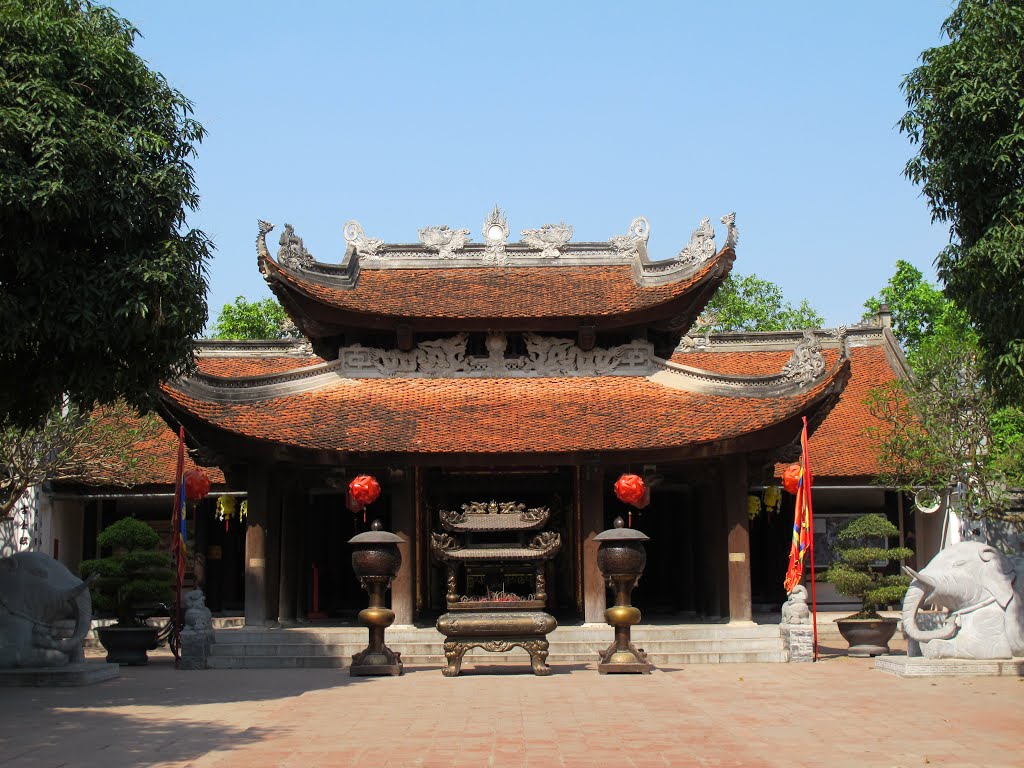Located in Dinh Bang Village, Tu Son Town, Bac Ninh Province, 15km from Hanoi
Do Temple worship the eight Kings of Ly Dynasty and is famous for its unique architecture.
Formerly, the Do Temple was famous for its architecture, highly praised through the verses:
“The architecture of the Do Temple is marvelous,
Worthy to the thousand-year-old history of Thang Long”
Do Temple was built during the Le Dynasty and has been altered several times since. The major reconstruction took place under the reign of Le Trung Hung, in the 17th century.

Do Temple
In front of the Temple lies a semi-circular lake, with clear and full water all the year round. The lake is connected with two ponds at both ends of the village, with the Tieu Tuong River in front of the village. In the center of the lake stands a square house reserved for water puppetry performances with two beautiful tiered roofs. To the south of the lake, there is a huge pavilion to preserve stone slabs inscribed with the merits of the eight kings of Ly Dynasty, and to the north of the lake, a 5-compartment floating house for visitors to take a rest.
The Temple’s gate includes five doors made of hard wooden plates assembled together and carved on top images of dragons waiting upon the moon. When the door opens, its two leaves are wide apart, and the two dragons on top of the doors seem to be soaring. On day, the dragons’ eyes when catching the light shine like gemstones. Along the three-step staircase, are carved two stone dragons with clouds around, on a green stone floor, symbolizing the Thang Long (Soaring Dragon) Capital.
Passing the gate and a large yard, a green stone paved road leads visitors to a square house, with eight tiered roofs and three compartments, 70m² in area. Then there is a 7-compartment front worship house, 220m² in area, whose front walls are hung with two big posters displaying capital letters: “Eight Kings together brightening” and “Co Phap Commune – a foundation of the Ly Dynasty”.
Then a three-compartment house, 80m² in area, with eight tiered roofs. These three compartments are spacious and ventilated and on the axis leading to the Co Phap ancient back pavilion, 180m² in area, and with the floor space in the shape of a Cong letter…
Different parts of the Do Temple are being restored one after another by skilful craftsmen. A rolling of drumbeats was suddenly heard, signaling the start of a procession to bring the tablet of King Ly Thai To from the Do Temple to the Ung Tam Pagoda where the King’s mother was worshipped for a reunion of the King and his mother. The procession was attended by a thousand of people, who expressed the spirit of the Vietnamese, i.e. “when drinking the water, think of its source”.
The land of Quang Binh is favored by nature, possessing a large, pristine system of both large and small caves, which...
The phrase “Mekong River – A Buddhist River” describes the cultural heritage of Buddhism in the...
The Independence Palace has been existing for 154 years; however, the Independence Palace you see today was erected in...
The resort is located 80 kms North of Nha Trang at the tip of an archipelago. It is absolute paradise – an ideal...
Being is one of the well-known beaches in the north of Vietnam, Do Son is a small peninsular formed by the stretch of...
Ca Na beach On the map of Vietnam tourism as well as the world’s, Ca Na is amongst the impressive names for a...
Entrance to the Cham Museum Situated in a quiet area of Da Nang City, Cham Museum was built in 1915 according to the...
Phu Quy Island, whose name means “rich and precious,” lies about 100 km to the east of Phan Thiet City;...